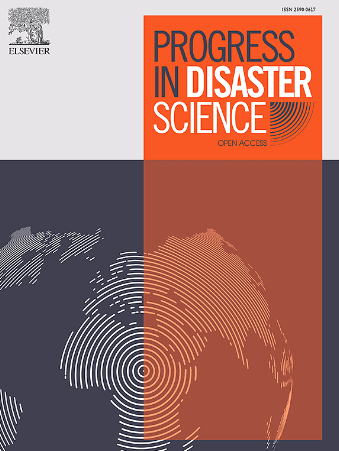From vulnerability to resilience: Examining the Sister Village program's approach to volcanic disaster risk reduction using the DROP model
IF 3.8
Q3 ENVIRONMENTAL SCIENCES
引用次数: 0
Abstract
This study examines the implementation of the Sister Village Program in enhancing community-based disaster resilience in Umbulharjo Village, located in the eruption-prone zone of Merapi Volcano. Using the Disaster Resilience of Place (DROP) Model approach, this research evaluates the key elements that shape disaster resilience, including mitigation, preparedness, adaptive capacity, and inter-village collaboration. The DROP Model integrates various components that influence a region's ability to manage, respond to, and recover from disasters, covering ecological, social, economic, institutional, and community competence aspects. This approach provides a comprehensive overview of a region's resilience to disasters and offers practical guidance for improving community and regional resilience. The study highlights the importance of planned mitigation and preparedness, and active community participation in reducing disaster impacts and accelerating post-disaster recovery. The Sister Village Program which involves knowledge exchange, infrastructure improvement, and strengthening the adaptive capacity of both villages, serves as an effective disaster risk reduction model. The findings also show that collaboration between villages and institutions, along with the strengthening of social infrastructure, play a crucial role in enhancing disaster resilience. The results of this study identify that by integrating these elements, the Sister Village Program can create stronger and more sustainable long-term disaster resilience. This model aligns with the Sustainable Development Goals (SDGs), particularly those related to disaster risk reduction and community capacity building. Thus, the Sister Village Program in Umbulharjo Village demonstrates significant potential for building sustainable resilience through an inclusive and collaborative community-based approach.
从脆弱性到复原力:利用DROP模型考察姊妹村项目减少火山灾害风险的方法
本研究考察了姐妹村项目在加强Umbulharjo村社区抗灾能力方面的实施情况。Umbulharjo村位于默拉皮火山爆发易发区。本研究利用地方抗灾能力(DROP)模型方法,评估了影响抗灾能力的关键因素,包括减灾、备灾、适应能力和村庄间协作。DROP模型整合了影响一个地区管理、应对和从灾害中恢复能力的各种组成部分,涵盖生态、社会、经济、体制和社区能力等方面。这种方法全面概述了一个地区的抗灾能力,并为提高社区和区域的抗灾能力提供了实用指导。该研究强调了有计划的减灾和备灾以及社区积极参与减少灾害影响和加速灾后恢复的重要性。姊妹村项目涉及知识交流、基础设施改善和加强两个村庄的适应能力,是减少灾害风险的有效模式。调查结果还表明,村庄和机构之间的合作,以及加强社会基础设施,在增强抗灾能力方面发挥着至关重要的作用。本研究的结果表明,通过整合这些要素,姊妹村项目可以建立更强大、更可持续的长期抗灾能力。这一模式符合可持续发展目标,特别是与减少灾害风险和社区能力建设有关的目标。因此,Umbulharjo村的姊妹村项目显示出通过以社区为基础的包容性和合作性方法建设可持续韧性的巨大潜力。
本文章由计算机程序翻译,如有差异,请以英文原文为准。
求助全文
约1分钟内获得全文
求助全文
来源期刊

Progress in Disaster Science
Social Sciences-Safety Research
CiteScore
14.60
自引率
3.20%
发文量
51
审稿时长
12 weeks
期刊介绍:
Progress in Disaster Science is a Gold Open Access journal focusing on integrating research and policy in disaster research, and publishes original research papers and invited viewpoint articles on disaster risk reduction; response; emergency management and recovery.
A key part of the Journal's Publication output will see key experts invited to assess and comment on the current trends in disaster research, as well as highlight key papers.
 求助内容:
求助内容: 应助结果提醒方式:
应助结果提醒方式:


